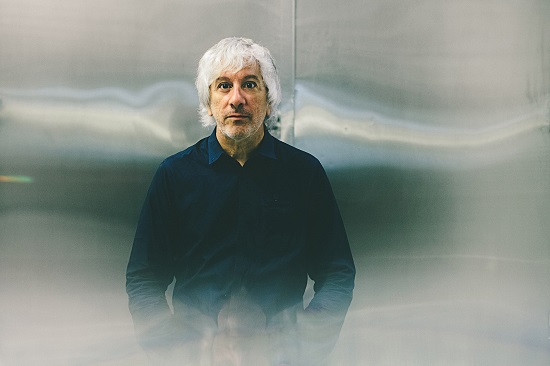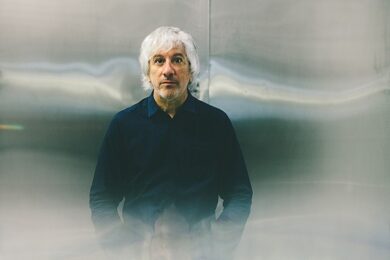Upon meeting my guitar hero Lee Ranaldo of Sonic Youth fame at a chic Shoreditch hotel prior to his acoustic gig at Rough Trade East, I bustled straight in for a friendly handshake and then proclaimed “Your film is great”, referring to the documentary Hello Hello Hello: Lee Ranaldo: Electric Trim, about his new record on Mute.
“You’ve seen that?”
I told him I’d not only seen it, I loved it, and that I’d listened to Electric Trim nine times already. “A good number” he said, seemingly pleased with my specificity, perhaps in symbiosis with the lyric of new song ‘Circular (Right As Rain)’ which ends with the couplet “You’re ancient/You’re epic/Overhauled/So specific”.
I also told Lee I’d seen Sonic Youth play on the Washing Machine tour and was assuaged that he thought it “a great era” and that I’d also owned one of the earlier experimental solo records East Jesus (“very obscure”).
There’s nothing ancient about Lee. Sure his hair is now a shock of white heat/white noise but he has a timeless twinkle in his eye and an easy affable way that give him an effervescent quality. He sure has been involved in some epic music, poetry and art since the late seventies and like Sonic Youth constantly re-evaluated and re-invented, he continues to do so as a solo artiste, with Electric Trim an effective full overhaul from his last album, 2014’s Acoustic Dust.
The new album opens up with a seven minute epic ‘Moroccan Mountains’ and a trademark Ranaldo spoken word passage “I was filming against the light when the landscape dropped down and we fell into the crack between the window and the world”, and this crack, this margin in music is effectively the area where Lee has operated, “For twenty years we had our screwdrivers out/Trying to disassemble the panels”.
From moving to downtown New York with his band The Flucts, to acting as Glenn Branca’s right hand guitar man and then co-founding Sonic Youth, Lee has used his sonic screwdriver to make alien sounds come from a guitar that had seldom before ever made such great outsider pop music. Open tunings, dropped D guitar mangling had never sounded so good. Lee’s scordatura outscored its contemporaries, and his plaintive vocals always made a fantastic counterpoint to the more guttural, animalistic sounds of Kim Gordon and Thurston Moore.
Ranaldo operated in the shadows of the spotlight cast by Kim and Thurston but he seemed happy, like the George Harrison of a 90s Beatles, and when he got to the mic he truly soared. A list of Lee’s songs from ‘Eric’s Trip’ and ‘Hey Joni’ via ‘Mote’ to ‘Wish Fulfillment’, ‘Karen Koltrane’ and ‘Hoarfrost’ feels like they alone would have made a fantastic album let alone be part of a stellar oeuvre of truly equal, collective songwriting.
It seemed only natural post-Sonic Youth that Lee would make more solo records. He’d already made some esoteric ones, but with Between The Times And The Tides in 2012 he truly consolidated his voice both as singer and singular artist. After a true new band record with Lee as leader – Lee Ranaldo and The Dust’s Last Night On Earth in 2013 and a 100% acoustic foray with The Dust on Acoustic Dust the year later, Ranaldo has been drawn back into a fully collaborative effort. Approached by Acoustic Dust’s producer Raül “Refree” Fernandez to build an album in the studio, Lee felt simultaneously at home to be throwing around ideas and yet out of his comfort zone because he was out of the practice room. If on Sonic Youth’s 1983 debut album Confusion Is Sex, “Lee Is Free”, here nearly 35 years later on Electric Trim due to Fernandez, you could say Lee is Re-free.
Also taking lyrical inspiration from friend and novelist Jonathan Lethem, this is an album that truly plays with form in joyous fashion, ranging from third party stories about rogue surgeons shucking off skin (‘Uncle Skeleton’) to Edgar Allan Poe homages in ‘Purloined’, via glitchy digital drums on the title song, or the almost Shepard tone eternal spiral of ‘Circular (Right As Rain)’. Lee has also assembled a cast of great players who drop in and out of the mix, including old oppo Steve Shelley of Sonic Youth, Nels Cline of Wilco, experimental guitar virtuoso Alan Licht, Oneida’s Kid Millions and recent acquaintance Sharon Van Etten on vocals including on the bittersweet duo ‘Last Looks’.
I came to guessing whom Lee might have chosen from a plethora of influences and collaborators for his Baker’s Dozen. There are some obvious ones like early friend Glenn Branca and later one John Fahey. John Cage is a gimme, plus some expected CBGB’s action, new wave, no wave and some of Sonic Youth’s left field friends and contemporaries, but there are plenty of surprises, which tie into the studio conception of Electric Trim. He was at pains to say that his favourite albums were in constant flux and had titled his list “ALBUMS/IMPORTANT LISTENING FOR ME/SHAPING MY MUSICAL THOUGHTS”. To reinforce the point, there was even a last minute addendum, a substitution of Joni Mitchell’s Song To A Seagull for Ladies of the Canyon.
Glancing at the list before our chat he realized “there’s obvious stuff I left out” – including The Velvets, The Stooges “and some other long standing influences. I don’t even know if there’s a Dylan record on there or a Neil Young record. I could have put Neil’s new Hitchhiker record down on there, that would have been a good one to put.”
Nonetheless here’s a snapshot of Lee’s current musical thoughts. A thoroughly engaging hour, with what felt like a long lost friend, was only interrupted by a fire alarm to which Lee sardonically said as I turned off the recorder, “you don’t want to record that?” and ended with an obscure chat about Merzbow CDs welded into a Mercedes. I left the hotel with Lee’s great stories ringing in my ears like a coruscating squall of fuzzy feedback, and it felt good.
Lee Ranaldo’s new album ‘Electric Trim’ is out now. A new documentary about its creation, Hello, Hello, Hello: Lee Ranaldo, Electric Trim, has its London premiere on November 14 at the Doc n Roll Film Festival, which you can find out more about here.
Ranaldo is currently touring the US, and will hit Europe next year. For all his dates, with more set to be announced, click <a href="http://www.leeranaldo.com/
" target="out">here.
To begin reading his Baker’s Dozen, click the image of Lee below.



